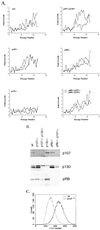Combinatorial roles for pRB, p107, and p130 in E2F-mediated cell cycle control
- PMID: 10995475
- PMCID: PMC27107
- DOI: 10.1073/pnas.190343497
Combinatorial roles for pRB, p107, and p130 in E2F-mediated cell cycle control
Abstract
Numerous studies have implicated the pRB family of nuclear proteins in the control of cell cycle progression. Although over-expression experiments have revealed that each of these proteins, pRB, p107, and p130, can induce a G(1) cell cycle arrest, mouse knockouts demonstrated distinct developmental requirements for these proteins, as well as partial functional redundancy between family members. To study the mechanism by which the closely related pRB family proteins contribute to cell cycle progression, we generated 3T3 fibroblasts derived from embryos that lack one or more of these proteins (pRB(-/-), p107(-/-), p130(-/-), pRB(-/-)/p107(-/-), pRB(-/-)/p130(-/-), and p107(-/-)/p130(-/-)). By comparing the growth and cell cycle characteristics of these cells, we have observed clear differences in the manner in which they transit through the G(1) and S phases as well as exit from the cell cycle. Deletion of Rb, or more than one of the family members, results in a shortening of G(1) and a lengthening of S phase, as well as a reduction in growth factor requirements. In addition, the individual cell lines showed differential regulation of a subset of E2F-dependent gene promoters, as well as differences in cell cycle-dependent kinase activity. Taken together, these observations suggest that the closely related pRB family proteins affect cell cycle progression through distinct biochemical mechanisms and that their coordinated action may contribute to their diverse functions in various physiological settings.
Figures



References
-
- Dyson N. Genes Dev. 1998;12:2245–2262. - PubMed
-
- Zhu L, van den Heuvel S, Helin K, Fattaey A, Ewen M, Livingston D, Dyson N, Harlow E. Genes Dev. 1993;7:1111–1125. - PubMed
-
- Lukas J, Parry D, Aagard L, Mann D J, Bartkova J, Strauss M, Peters G, Bartek J. Nature (London) 1995;375:503–506. - PubMed
-
- Qin X Q, Chittenden T, Livingston D M, Kaelin W G., Jr Genes Dev. 1992;6:953–964. - PubMed
-
- Nevins J R. Curr Opin Genet Dev. 1994;4:130–134. - PubMed
Publication types
MeSH terms
Substances
LinkOut - more resources
Full Text Sources
Other Literature Sources

